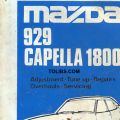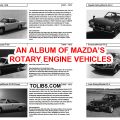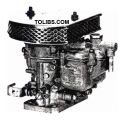Mazdaspeed Competition Catalog 1997

Competition Apex Seal Information
Carbon apex seals and Iannetti Advanced Carbon seals are recommended for any engine that will see 8000 rpm and above. They weigh significantly less than the stock (cast iron) apex seals and provide lower mass, keeping the apex seal in contact with the rotor housing face at high rpm. At high rpm, the stock (cast iron) seal overcomes the spring, causing the seal to skip across the rotor housing surface, reducing engine performance. Cast iron seals also can warp at high rpm.
Iannetti Advanced Carbon Apex Seals
Design
The two (2) spring design allows for a higher spring pressure which helps improve chamber sealing. This design feature allows the engine to be run with a higher degree of timing before “ TDC,” retarding the onset of pre-ignition or detonation and effectively increasing the engine’s horsepower capabilities. The insignificant wear characteristics of the material allows the use of almost double the apex spring pressure than could be used with other stock or carbon apex seals. This capability also contributes to better sealing, thereby improving the containment of the combustion chamber pressures, which in turn, assists in preventing the onset of detonation.
Material
The apex seal material exhibits the following qualities: high strength, low friction and lightweight (lower than ferrous-based seals). Recent material composition improvements have been made, especially in the case of the 2 mm Iannetti apex seal used for turbo applications. The Iannetti 2 mm seal can handle over 50% more stress on the apex seal beam cross-section than the 3 mm stock seal for normally aspirated 13B engines.
Benefits
- Provides excellent sealing characteristics at all temperatures
- Withstands damaging engine detonation
- Will not absorb moisture when engine is being stored
- Ideal for turbo applications
- Iannetti seals have been used by most major professional teams in the world:
- Winner of the 1994 IMSA World Sports Car Championship, Wayne Taylor – Team Downing/Atlanta.
- 3rd in Class at the 24 Hours of Le Mans, 1995 - MazdaSpeed – Team Downing/Atlanta.
- 3rd overall at the Rolex 24 Hours of Daytona, 1996 – Team Downing/Atlanta.
- 1st in Class at the 24 Hours of LeMans, 1996 - MazdaSpeed – Team Downing/Atlanta.
NOTE: Carbon and Iannetti Advanced carbon apex seals must be used in conjunction with the proper apex seal springs.
Iannetti Advanced Carbon Apex Seals require two (one short/one long) apex springs. Springs come with Ianetti Ceramic seals.
Please follow the information provide below for correct fitment and to achieve ideal sealing characteristics:
12A (Part #0000-01-9101 – 3 mm) - Use Part #1757-11-304 for both springs. Inner (short) spring must be cut to 52 mm length. Outer (long)
spring must be cut to 65 mm length. Taper ends to 15 degree angle.
13B (Part #0000-01-9102 – 3 mm) - Use Part #1757-11-304 for both springs. Inner (short) spring 3 mm must be cut to 58 mm length. Outer
(long) spring must be cut to 74 mm length. Taper ends to 15 degree angle.
13B (Part #0000-01-9103 – 2 mm) - Inner (short) spring must be cut to 58 mm length. Outer
(long) spring must be cut to 74 mm length. Taper ends to 15 degree angle. (NOTE: The stock Apex
Spring (Part #N326-11-C06A) is used for the springs (cut inner to 58 mm length).
Quarter Master Clutch Tech Tips
Moment of inertia, with respect to rotation, is called angular momentum. Angular momentum is the force that has to be overcome to spin a circular component (e.g., a flywheel and clutch). It is a function of the mass of the part and the radius on which the mass is positioned. The more centered the mass is on a circular part, the lower the angular momentum, and the less horsepower is needed to spin the part. This translates to the flywheel/clutch assembly being able to accelerate faster at every rpm range.
For example, Quarter Master’s aluminum flywheel and 7-1/4" aluminum clutch unit together are rated at 146.3 inch-pounds. In other words, the assembly requires approximately 146.3 inch-pounds of force to initiate movement. In comparison, Quarter Master’s aluminum flywheel and the new compact 5-1/2" aluminum clutch unit require approximately 101 inch-pounds of force to initiate movement (a 30% reduction).
Installation Tips
Check for any oil leaks
If any trace of oil is found within the bellhousing or at the back of the engine, determine the source and replace the seal or gasket.
Pilot bearing inspection
Before installing your new Quarter Master clutch, carefully inspect the pilot bearing for wear. Replace the bearing if any wear is found.
Bellhousing alignment inspection
To prevent input shaft and clutch hub spline wear, check to ensure that the transmission face of the bellhousing is square to the eccentric shaft face (within .002" indicated runout). The bellhousing must be machined flat if outside of this measurement. The transmission receiver hole of the bellhousing should be concentric to the eccentric shaft (within .006" indicated runout). If not within specifications, you will need to relocate the dowel pins on the engine block.
Input shaft inspection
Be sure the clutch discs slide all the way down the input shaft without binding. Check for any signs of twisting or bending of the input shaft. Quarter Master does not recommend using anti-seize compound or any other lubricant on the input shaft splines.
Flywheel installation
Insert the 5/16" (grade 8) bolts into the flywheel from the back side. (This is not required of flywheels with spline nuts.) Bolt the flywheel to the eccentric shaft and torque as required. Use Loctite® and/or safety wire to secure these bolts (do not use star washers).
Clutch housing installation
Install the clutch housing over the 5/16" bolts, placing it squarely onto the flywheel. Index one 5/16" bolt head against the lip of the back side of the flywheel. Check to ensure the bolt fits freely into the housing. Any binding of these bolts can cause serious damage to the clutch, clutch pack and floater plate installation.
Quarter Master clutch packs for rotary applications include one end disc and one center disc. The hub of the end disc protrudes from only one side. The hub on the center disc has a flat hub which protrudes from both sides of the disc.
Install the clutch pack and floater plate in this order:
- Install the center clutch disc (in either direction).
- Install the floater plate (in either direction).
- Install the end disc with rivet heads (stamped Q.M.I.) facing the engine.
Pressure plate and clutch cover installation
With clutch pack and floater plate in position, install the pressure plate into the housing with the flat side against the disc. Then, install the clutch cover onto the housing, checking dowel pin alignment (7-1/4" clutch only). The cover fits on one way. Install the washers and tighten (finger tight) the nuts onto the clutch bolts. Using an alignment tool or input shaft, align the clutch discs and torque to 20 foot-lbs.
Release bearing
Use a Quarter Master radius-faced release bearing - do not use a stock bearing. Minimum clearance between the release bearing and clutch fingers should be .125". Be sure to install a return spring to keep the bearing from riding on the clutch fingers. In addition, a stop should be installed to limit clutch pedal travel. Over-traveling the diaphragm spring (clutch fingers) will shorten the life of the clutch and lead to premature failure of the engine thrust bearing.
Differential Information
As a rule, differential temperatures should stay below 200° Fahrenheit range. Consistent temperatures above this level can reduce the service life of the limited slip and differential significantly. A new differential and limited-slip unit should be broken in over a period of approximately 200-300 miles. Operating temperatures that slightly exceed 200° F during this period are normal. A 90W hyoid gear oil should be used for the break-in period. Thereafter, we recommend switching to a synthetic gear lube that is compatible with limited-slip differentials. Torsen-Gleason differentials do not require limited-slip gear oil.
Setting Up the Ring & Pinion
Use the stock factory specifications in your shop manual for adjusting the ring & pinion. Attaining the proper tooth contact pattern is essential to obtaining the optimum service life from the ring & pinion. For racing purposes, a tooth pattern that contacts at the edge or “toe” side of the teeth is preferred. This type of contact pattern will make more noise than a “centered” contact pattern; however, it will reduce the chance of teeth breakage. Gear marking compound will provide the most accurate display of the ring-to-pinion gear tooth pattern. After obtaining the desired tooth pattern, follow the recommended preload specifications in your factory service manual. We recommend use of a new crush collar each time you rebuild the differential. Replacing the pinion bearings is also recommended. See the Mazda Special Tool section in Appendix A of this catalog for a listing of differential tools available.
Installation Tips
When installing a limited-slip unit, new side bearings should be purchased, as old bearings are normally damaged when removed. If you are installing the competition limited-slip unit in a 1980 or earlier model, the axle shafts must be modified. Remove 1/8" from the inner end of each axle.












